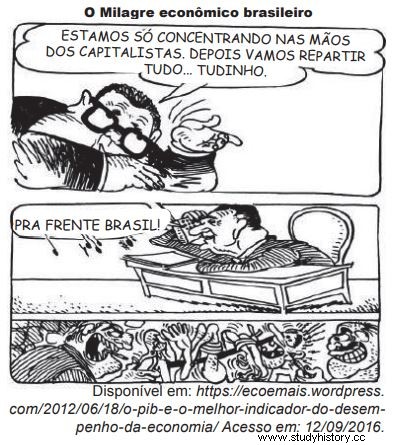"Brazil, love it or leave it" was one of the famous slogans of the military regime, around 1970, when the Medici Government promoted the image of "Great Brazil" and proclaimed the " Economic Miracle" that would make the country a great power.
 |
| The Brazilian Economic Miracle. |
A) the Brazilian “miracle” further accentuated social and regional inequalities, causing a high concentration of income.
B) the role of the State in infrastructure works:telecommunications , roads, energy was significant and modernizing, although carried out with private capital.
C) the government's social programs grew at the same pace as the economy and there was a significant growth in the areas of health and education.
D) the great economic prosperity contributed to prevent the process of social exclusion of most of the society that did not benefit from the “miracle”.
E) that the national economy, despite intense growth, was not able to improve the level of wages, making it difficult by workers of consumer goods.
Question 07 - UFPB 1989 - The Brazilian “economic miracle” (1967-1973) was supported by bases,
among which stands out
a) and worker protection, through a policy of increasing salary increases.
/>b) the equitable redistribution of income among all social segments.
e) the realization of an effective agrarian reform.
d) the decrease in exports.
e) the external indebtedness and the concentration of income.
Question 08 - UNIFOR - 2001.1 - During the military dictatorship (1964-85), the bases on which the "economic miracle" was built - foreign loans, multinational investments, wage squeeze, internationalization of the economy,
(A) made clear its vulnerability in relation to international crises , the increase in social inequalities and regional and sectoral imbalances.
(B) they had a profound impact on the recovery of the economy, on the reduction of the public deficit, on the regression and on the stabilization of the inflation index.
(C) they transformed the country into an economic power capable of competing with the great industrial powers of the world.
(D) they made clear their objective in relation to the development of an independent economic policy model.
(E) they included measures to control foreign investment in the sectors strategies of the national economy.
Question 09 - FEPESE - 2014 - MPE-SC - The period 1968-73 is usually called the “Brazilian miracle”, due to the fact that the Brazilian economy registered high growth rates with relatively low and controlled rates of inflation. In relation to this period, it is correct to say:
a) The expansion of the Brazilian domestic market was due to the vigorous policy of raising real wages, which boosted consumption by low-income families.
b) The national economic growth at the time was mainly due to the ample international liquidity promoted by the dynamics of Eurodollars, which made it possible for the government and private capital to contract foreign loans.
c) The economic growth of the period was due to - mainly to the expansion of domestic consumption, since the exchange rate policy reduced the competitiveness of Brazilian exports.
d) The economic growth of the period was marked by the expansion of employment and, consequently, by the improvement in the distribution of income.
e) Investment in the period increased due to the greater participation of the private sector, with public sector investment and government subsidies not playing an important role in economic expansion. private sector.
Question 10 - FAMERP 2017 - 1st day - The so-called “Brazilian miracle”, which took place during the military regime (1964-1985), was marked
a) by the implementation of basic industry, driven by the inflow of strong North American and European investments.
b) accelerated economic growth, associated with increased social inequality and external indebtedness.
c) by overcoming hyperinflation, which eroded workers' wages and made new investments unfeasible.
d) by the fall in industrial activities, which caused a retraction in the production and consumption of durable goods.
e) by supporting the production of coffee for export, stimulated by the expansion of consumer markets in Europe.
Question 11 - UVA 2003.1 - Occurred between 1969 and 1974, it was characterized by an economic euphoria caused mainly by the increase in loans abroad, by the construction of large works such as the Transamazônica and the Rio-Niterói Bridge. The text refers to a stage in our history, Known as:
A. It was Vargas.
B. First Republic.
C. Brazilian miracle.
D. It was Kubitscheck.
Question 12 - UVA 2012.2 - CG - The military coup of 1964 was accompanied by changes in the political organization of Brazil, with the forfeiture of political rights, the closing of parties and censorship. From 1969 onwards, a period known as the Brazilian miracle began. Tick below the alternative that does not present action developed by the Brazilian government during the period of the economic miracle.
A. The economy grew at high annual rates.
B. Great increase in industrial production.
C. Export growth and strong use of foreign loans.
D. Creation of Petrobrás.
INTRODUCTION
01 - D
02 - B
03 - E
04 - D
05 - A
06 - A
07 - E
08 - A
09 - B
10 - B
11 - C
12 - D
